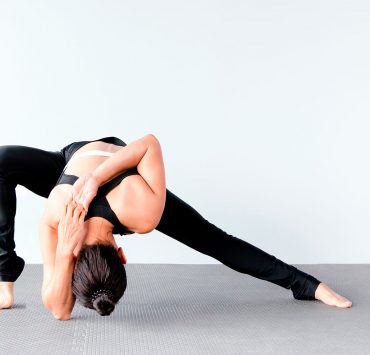
A graduate of Arizona State University, Nicole Baker is a…
In yoga classes all over the world, instructors methodically direct students to set their intention at the beginning of a yoga class. Often there is no guidance as to what an intention is with little time to ask much less practice. Students may go through years of practice without having a clear idea of what an intention is and even less of an idea how to create an authentic one. However, intentions can be powerful tools to help guide a practice and become present in the moment.
What Is an Intention?

In Sanskrit, an intention is called a sankalpa. Sankalpa is the union between kalpa — the rule to be followed above all other rules and “san”, – a connection with the highest truth. It has been defined as “a one-pointed resolve to focus both psychologically and philosophically on a specific goal.”
According to Richard Miller, Ph.D., a clinical psychologist and yoga instructor, there are two types of intentions, the first is heartfelt desire and the second is an intention to work towards. The heartfelt desire intention is an intention that is an affirmation of our truest self that comes from our true nature. It is not an intellectual pursuit be something the body already knows such as “I am complete”. The second intention– an intention to work towards is a way to cultivate what will bring us to our truest selves but we are currently in the process of working on– even if we are not aware of. Some intentions we may already feel and are aware of while others are something inside of us that is still unfolding.
Here’s what an intention is not: a goal. This may seem a little confusing because isn’t what we’re trying to cultivate a goal? However, when an intention becomes a goal we begin to not only judge our yoga practice but we judge ourselves. We start to strive for the intention and judge our practice if we did not feel like we were good enough. Instead of accepting what is already inside of us as being whole and complete, we begin to try to be something we are not or someone else’s ideal.
Why Is it Practiced?

Yoga is an excellent time to cultivate an intention because not only can it help guide our mind and body throughout a practice but hopefully it is something we can continue to expand once the asana practice is complete.
It can also help ground us during our practice and bring us back to our purpose. For example, imagine an intention is “I am at ease” but yet during yoga we are practicing a sun salutation with too much intensity or too much struggle. If practicing an arm balance even though we are exhausted and lost control of the breath, we are moving away from the intention. However, if we constantly bring to mind ease– we can adapt our postures to practice the intention.
Discovering an Intention

Intentions can be challenging during a yoga class because often times the yoga instructor only gives a few seconds to arrive at an attention. Therefore, it is helpful to practice building an intention before class. Miller recommends a three-step process for becoming aware of the intention is:
1. Listen: Stop trying to search and have the courage and openness to listen and be still.
2. Welcome the message: Whatever pops up by feel completely in sync with where we are at in our lives but it may also depict where we can be. Sometimes this can be overwhelming. It’s important to just trust that our body and mind has its own inner wisdom.
3. A willingness to act: Once our true selves are revealed as having the courage to act on our intentions.
A meditation practice can help quiet the mind and draw the awareness inwards. Practicing allows us to listen to what the body and mind already know and give it space for the intention to arise. By finding some time and a quiet place to practice and practicing daily, we can begin to listen to ourselves and discover our true nature.
There are many ways to meditate but it’s also important to realize that sometimes by trying to get something out of the meditation or forcing a timetable on it, we can get in our own way. If meditation is challenging, try some of the guided meditations online made specifically for discovering our true intentions.
Refining the Intention

Once an overall intention is decided, crafting it into a simple statement to practice in a yoga class can help make it easier to incorporate into the practice.
1. Intentions should feel realistic and possible. If creating an intention that feels unauthentic or impossible, change it to something more achievable so it feels possible and attainable.
Example:
I am happy.
For some people this statement may resonate, however for people feeling unhappy right now may feel like a lie. As soon as they repeat it, it may feel false, phony, and unattainable. There may even be a physical reaction rejecting the statement such as a clenching in the jaw or tightening of the shoulder muscles. However, by using words such as “I have the ability” or “I welcome” it makes it more realistic and possible.
I have the ability to be happy.
Notice how the body feels as the intention is repeated over and over either silently or verbally. Does the body tighten up anywhere or does it feel at ease? If it tightens and does not feel authentic, use words that focus on the ability or practice to help make it palatable.
2. Long and wordy intentions are not only difficult to remember but are hard to focus on during a practice because simply too much going on to keep track of. They become scattered. By making them shorter and simple, they are easier to practice with.
Example:
“I am flexible, strong, at ease, and able to receive everything in the present moment.”
Consider changing wordy intentions to something either all-encompassing or shorter to what the needs are in this specific moment:
“My body is healthy.”
Listen to the mind and body daily to see what feels most crucial in the present moment to utilize the appropriate attention for that yoga class.
3. Intentions cultivate what we want in life ……..not what we do not want in life.
Example:
“I don’t want to be upset” or “I’m not upset”
By focusing on what we don’t want, not only are we not identifying what we want to cultivate in our lives but we are practicing a mantra that continues to attract negative patterns.
Instead, focus on what you are trying to cultivate:
“I am at ease” or “I have the ability to be at ease”
4. Intentions are in the present. As intentions are what’s already inside of us, they should always be in the present tense format instead of the future.
Example:
“I want to be peaceful”
The body and mind has its own inner wisdom and knows what we already are even if it’s not fully realized. By using words such as “I want”, it fails to recognize that we already have the ability. Instead of practicing being peaceful we are practicing striving and cravings to be something else. Instead try intentions such as:
“I am at peace” or “I welcome peace”
5. Sometimes intentions can seem superficial, Anne Douglas, a yoga therapist based out of Alberta, recommends investigating our superficial intentions versus shying away from them or shooting them done. For instance, if the immediate intention that arises is “I want to lose weight”– try to understand the why behind it. Perhaps it’s more “I am here for my family” or “I am healthy” or “I have a long life”. By trying to understand some of the reasoning behind what may seem to be trivial desires, we can create more powerful affirmations to work with during a yoga class.
Intentions to Take Off the Mat

Once a yoga class or personal practice is complete, the intention has hopefully been brought to the forefront of the mind a few times. Try to repeat the intention silently a few times before class ends or after class to bring it to focus throughout the day. For instance, if the intention is “I am flexible” — is it possible to be flexible when someone asks us to changes plans as opposed to keeping a rigid schedule? If the intention is “I am strong”, could we have the strength to tell someone we love no when they ask us for a favor because it’s not good for us right now. By being curious about the intention and trying to carry it with us through the rest of the day, we are becoming closer to our true selves.
Conclusion
Intentions can be very powerful tools to not only work with our own inner guide but to cultivate positive change around us. By practicing intention setting with our yoga practice we can help bring it to the present tense and integrate with our daily actions.
What's Your Reaction?
A graduate of Arizona State University, Nicole Baker is a force to be reckoned with in the realm of health and wellness. She studied behavioral health, which propelled her desire to live holistically and share her knowledge with other like-minded individuals.














